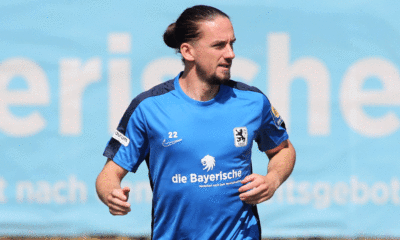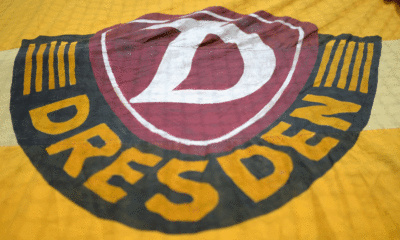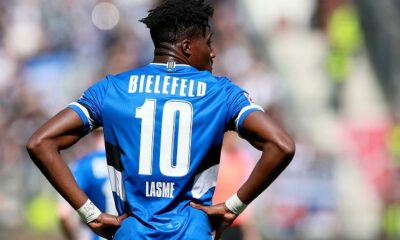Bundesliga
What Musiala has mastered, what he still has to work on
Published
3 years agoon
By
Maria Keane
Steffen Tepel (36) used to take part in the World Cup as a Nordic combined athlete, today he works as a neuroathletic trainer and helps the football stars of tomorrow with targeted exercises for the brain and eyes to become even more agile and (thought) faster on the lawn. Including: Jamal Musiala (18) from FC Bayern Munich.
In an interview with SPOX and Goal reveals to Tepel what he is working on in detail with the young international, what neuroathletics is all about and why the DFB surprises him. In addition, the coach has a plausible explanation for why Leroy Sane (25) feels more comfortable on the left wing than on the right.
Mr. Tepel, neuroathletic training is becoming more and more popular among professional athletes. What does it mean?
Steffen Tepel: Basically, neuroathletic training is about improving movement control via the brain. You don’t focus specifically on training individual muscles, but use the sensory systems to activate the brain – for example the eyes or the balance system. Neuroathletic training creates the basis for high-quality movements, such as coordination or stabilization movements. If these movements fit, you will benefit significantly more from normal training in everyday life. The aim is to elicit further potential from the body and thereby to be more alert, faster and more agile. That helps in football, but also in all other sports where fast and efficient movements make the difference.
What is a typical neuroathletics exercise for soccer players?
Tepel: You dribble without looking at the ball and instead fixate your eyes on a point in the distance. This improves your peripheral vision and what we call foot intelligence. Dribbling is nothing more than a complex movement that arises from neural input from various senses. I have to control the ball, at best at top speed, but at the same time I have to look at where my fellow players and opponents are. Then I still need my balance system so that I don’t fall over when I move sideways, but rather to regain my balance as quickly as possible. That’s why it’s important that my feet feel where the ball is. Of course, that doesn’t mean that I won’t even look at the ball in the game. But if you can control the ball without looking at it all the time, you automatically have better ball control. You not only perceive the ball better, but also what is around it.
Sounds like additional training that makes sense.
Tepel: Exactly. Technique and fitness training is indispensable for every footballer, but this is sufficiently implemented within the clubs. This is why neuroathletic training is an add-on – but in such a way that there is also a certain regularity.
Bavarian jewel Musiala? “An excellent work ethic”
You come from competitive sports yourself, were Nordic combined athletes until 2011 and competed in the World Cup before you worked in the coaching team of the Swiss national team Nordic Combined after your active career. When and how did you hear about neuroathletics?
Tepel: That was in 2013 while preparing for the Olympic Games with the Swiss team. Back then, as a young coach, I had the same training as I was used to, I basically reeled off my entire repertoire of sports studies. As a side note, I picked up the subject of neuroathletics and quickly noticed: There is a completely different depth to it, you can achieve so much more success in a short time than with conventional training in the weight room. That’s why I booked Lars Lienhard, who was the first to implement this approach at the time. He brought us closer to neuroathletics step by step.
Lienhard is considered a pioneer for neuroathletic training in Germany.
Tepel: The trend originally comes from the USA, especially Dr. Eric Cobb played a big part in this and, like many coaches in this country, trained me. Prof. Dr. Frederick Robert Carrick did a lot of groundwork. But yes: Lars brought neuroathletics to Germany and created a certain credibility for the topic. He has written books and was part of the DFB support staff at the World Cup in Brazil as a neuroathletics expert in 2014, and later he also trained with Serge Gnabry. In general, one has to say: In other European countries there is not yet as much emphasis on neuroathletic training as in Germany, but there, too, the interest and discussion of the topic is increasing.
Which is now also up to you. After the Olympic Games in 2014, you dealt intensively with neuroathletics and, in 2020, together with two other trainers, founded the company “INPUT1st”, which focuses exclusively on neuroathletics training.
Tepel: We only worked with winter sports enthusiasts and young footballers on the side and participated in further training courses. At some point, the successes and feedback were so good that we said: It makes sense to start your own company.
They mainly specialize in soccer.
Tepel: We have developed two training curricula: One general for all sports and one specifically geared towards soccer – because soccer, like all ball sports, has a different complexity and we work with more soccer players and, in this regard, especially with young soccer players who are on their way to becoming professionals are located or have already arrived there.
Including Jamal Musiala – the talent in Germany that everyone is currently talking about. He has been training under your direction on a regular basis since moving from Chelsea to Bayern in the summer of 2019. How big is your part in its development?
Tepel: Jamal’s success is primarily due to his exceptional work ethic. As a result, he has appropriated things, as Julian Nagelsmann recently said: He plays as if he had a magnet on his foot. When it comes to dribbling, you can’t teach him that much anymore, even at 18, his one-on-one fantasy is simply a special gift. He has an incredibly good sense of where the ball is around him and what is happening in the zone he is in. His coordination, coupled with his technical skills and his typical, lightning-fast side movements, make it possible for him to meander through the opposing lines. These are high neural requirements that Jamal is great at. But he’s also a very ambitious boy who works on himself like an obsessive man and, in addition to his training at FC Bayern, always wants to improve things. And this is where we come in.


Test match tournament on free TV and live stream
In preparation for the upcoming start of the season in the 2nd and 3rd divisions, SpVgg Unterhaching is organizing a...


Test match on free TV and live stream
Third division club Dynamo Dresden are testing today against top Czech club Slavia Prague in preparation for the upcoming start...


When does the season start?
It’s warm and sunny outside, but you just want to watch football again? Then get in the mood for the...

